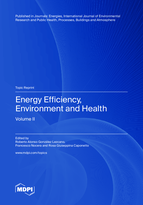Topic Menu
► Topic MenuTopic Editors



Energy Efficiency, Environment and Health

A printed edition is available here.
Topic Information
Dear Colleagues,
Cities are widely recognized as risky environments for humans. Risks to health and well-being are measured in three groups of indices: physiological, emotional and cognitive. Environmental factors discussed in studies include physical factors such as noise, heat load and air pollution, and social factors such as feelings of discomfort, crime, transportation and access to health services. Some studies even argue that stress and health risks are intrinsic to urban environments and that restoration is intrinsic to green environments. This Topic aims to discuss what spaces can be greened and the effect this has on urban environments. It also discusses the effect of the size and layout of parks, vegetation on the walls and roofs of houses, and the effects of different types of vegetation, building materials, and energy efficient design.
Recent events have challenged the way the built environment is designed, managed and experienced. Droughts, wildfires and a global pandemic have undoubtedly forced the building industry to find ways to cope with unpredictable events and to respond to a broader and more complex set of requirements. Today's environment demands new design processes, construction techniques, occupancy practices, and management strategies to increase the resilience of the built environment to extreme, uncontrollable, and unpredictable events while providing healthy and sustainable environments for people. This Topic invites researchers that address this topic to reflect on what the new concept of sustainability for the built environment should be, and to guide new research directions.
The aim of this Topic is to add knowledge to the information on the greening of our cities. We invite the authors to raise awareness of different aspects of the problem or to contribute relevant knowledge on any of the aspects mentioned above.
Prof. Dr. Roberto Alonso González Lezcano
Dr. Francesco Nocera
Dr. Rosa Giuseppina Caponetto
Topic Editors
Keywords
- environmentally friendly processing
- wastewater
- thermal comfort
- air quality monitoring
- indoor environment quality
- building innovation systems
- health outcomes
- housing and health
- smart home for health
- smart home for elderly care
- efficient interior lighting systems
- acoustics
- infrasound
- environmental buildings
- passive building strategies
- air pollution
- energy efficiency
- sustainable materials
- green architecture
- sustainable architecture
- healthy architecture
- sustainable construction
- smart construction
- high-performance building
- sustainable processes
- sustainable development
- energy policy
- energy regulation
- green energy
- energy environmental impact
- greenhouse gases
- energy technologies
- biological processes
Participating Journals
| Journal Name | Impact Factor | CiteScore | Launched Year | First Decision (median) | APC |
|---|---|---|---|---|---|

Energies
|
3.2 | 5.5 | 2008 | 16.1 Days | CHF 2600 |

International Journal of Environmental Research and Public Health
|
- | 5.4 | 2004 | 29.6 Days | CHF 2500 |

Processes
|
3.5 | 4.7 | 2013 | 13.7 Days | CHF 2400 |

Buildings
|
3.8 | 3.1 | 2011 | 14.6 Days | CHF 2600 |

Atmosphere
|
2.9 | 4.1 | 2010 | 17.7 Days | CHF 2400 |

MDPI Topics is cooperating with Preprints.org and has built a direct connection between MDPI journals and Preprints.org. Authors are encouraged to enjoy the benefits by posting a preprint at Preprints.org prior to publication:
- Immediately share your ideas ahead of publication and establish your research priority;
- Protect your idea from being stolen with this time-stamped preprint article;
- Enhance the exposure and impact of your research;
- Receive feedback from your peers in advance;
- Have it indexed in Web of Science (Preprint Citation Index), Google Scholar, Crossref, SHARE, PrePubMed, Scilit and Europe PMC.

